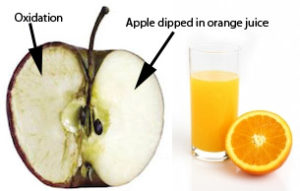 Recently my daughter did a science fair project on fruit ripening. Under my guidance and with some suggestions from the internet, she set out to conduct an experiment. She would be testing the hypothesis (educated guess) that liquids, especially acidic liquids, would slow down the browning of an apple. She cut a Gala apple into four slices, dipped them into orange juice, milk, water, and had a control slice which was not dipped. She then checked and rated the browning at 30 minute intervals for the next four hours. Acids and liquids theoretically slow down the rate of browning because they inhibit oxygen from coming into contact with enzymes that catalyze chemical reactions. However, at four hours, none of the apple slices looked very brown, including the control which didn’t have a treatment. Because of this, my daughter could not support her hypothesis that that the liquids slowed down the browning. This left us wondering why, so we started looking into the matter!
Recently my daughter did a science fair project on fruit ripening. Under my guidance and with some suggestions from the internet, she set out to conduct an experiment. She would be testing the hypothesis (educated guess) that liquids, especially acidic liquids, would slow down the browning of an apple. She cut a Gala apple into four slices, dipped them into orange juice, milk, water, and had a control slice which was not dipped. She then checked and rated the browning at 30 minute intervals for the next four hours. Acids and liquids theoretically slow down the rate of browning because they inhibit oxygen from coming into contact with enzymes that catalyze chemical reactions. However, at four hours, none of the apple slices looked very brown, including the control which didn’t have a treatment. Because of this, my daughter could not support her hypothesis that that the liquids slowed down the browning. This left us wondering why, so we started looking into the matter!
It turns out that there actually is a genetically modified apple approved by the FDA called an Arctic Apple. The Arctic Apple has been genetically modified so that it does not produce the ripening enzyme. However, my daughters experiment used Gala. Gala and many other varieties such as Empire and Cortland don’t ripen very quickly, and because of this are touted as being great to use in salads or gelatin deserts. These varieties are either natural, or in many cases produced by cross breeding. Some scientists have concerns that by turning off the production of the browning enzyme, it might prevent other helpful properties as well. For example, the browning process might protect the apples from certain pests thereby requiring producers to use more pesticides in these varieties.
Nutritionally, a brown apple slice is not any different from a fresh. However, the browning may indicate that the cut apple has been sitting too long, which compromises quality and safety. Because of this, after cutting apples they should be refrigerated if not eaten within two hours. Additionally, there are many great ways to preserve apples, including dipping them in Vitamin C, or lemon juice before refrigerating, or freezing. Proper preservation of a cut apple is important, especially because apples provide a variety of health benefits. In fact, apples and other tree fruit such as peaches, pears, plums, and apricots(PDF) are high in fiber, Vitamins A and C. In red apples, a nutrient call Quercitin has been linked with lung health. Most of the nutrients, like Quercitin are found in the skin, so it is best to consume an apple with the peel still on, whether it be fresh or frozen. If eating cooked apples is more your style, baking is a better cooking method than boiling for nutrient retention. Alternatively, if you choose canned apples, be sure to consume the canned liquid as well since it will have water soluble vitamins.
It’s important to note that with any technology, there may be legitimate concerns with advancement. That being said, food scientists have given us apples that are pretty good all year round, and are easy to put on the table as a grab and go snack. Oh my daughter did get an A, but her explanation was not as nuanced as this.

